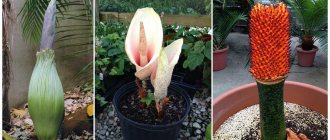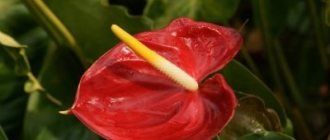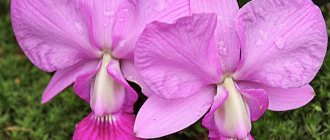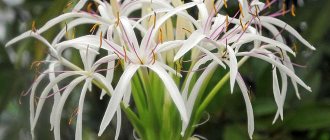Introduction
How did I first become acquainted with the beautiful flower “Bride and Groom”? My passion is growing indoor plants. They decorate the house with unusually bright flowers and variegated leaves. Watching how green pets develop is very interesting. In the spring, a friend gave me a small cutting of a plant and said that it was called “bride and groom”.
People gave a flower called campanula the romantic name “bride and groom”
I put it in water and a few weeks later, when roots appeared, I planted it in a pot. I used a soil mixture of greenhouse and leaf soil, peat and sand. The cutting took root easily and began to grow.
I placed the container with the plant in a deep tray and poured settled water into it every morning so that the plant did not lack moisture. Once every two weeks I watered it with special fertilizers for beautifully flowering indoor plants.
I pinched the quickly growing side shoots, and soon the bush became very branched and lush, numerous buds appeared on it, which bloomed one after another.
Composition of campanula and coleus
And somehow the plant became covered with the most delicate flowers. The bride and groom plant looked great on the window. In the summer I put it on the balcony, where she felt especially good.
After a long flowering at the end of summer, the campanula dropped its leaves, the shoots stretched out, I carefully cut them off and put the container in a cool place. With the onset of spring, I began to water the plants again and placed it on the windowsill. Soon new shoots appeared and already in mid-May the “bride and groom” pleased with their flowering again.
Zamioculcas (Dollar Tree) (140 Photos & Videos) - home care, transplantation, propagation + Reviews
Milkweed propagation methods
A flower can reproduce in two ways:
- Using cuttings;
- Seeds.
This plant is rarely propagated using cuttings. It is more often and easier to plant this flower with seeds. But if you decide to plant a plant in this way, then you need:
- cut off a cutting that has at least one bud;
- place it in a glass of warm water (this must be done so that the plant stops secreting a white liquid, which interferes with the formation of the subsequent root system);
- then the cuttings are dried for two hours in a cool, dark room;
- After drying, the cuttings are planted in open ground consisting of peat and sand.
Euphorbia bush from cuttings
When growing Euphorbia seedlings from cuttings, use individual gardening gloves. The white juice of this plant contains a substance that irritates the outer layer of the skin and causes allergic reactions. Be careful.
If you do not remove the plant from the flowerbed before the cold weather, it will drop its seeds into the soil, which will germinate next spring. In this way, you will not take any part in sowing the plant. In the spring, you simply plant the sprouts in rows or shapes as you like.
If you are planting Euphorbia for the first time, it is better to scatter the seeds into the soil in early spring or before winter cold snaps. This way you will know exactly where the flowers are planted.
Plants for rock gardens that bloom in autumn
The onset of autumn is not yet a reason to close the flowering season of the alpine hill. Plants that will delight you until the coldest weather - in conclusion of our review.
Common heather
Heather, which blooms at the end of summer and ends only in mid-autumn, will help you to plunge into the aroma of Scottish meadows. Moreover, dried flowers, similar to small bells, do not fall off, so it seems that the heather blooms until winter. Depending on the variety, its flowers acquire a variety of shades - from snow-white and soft pink to deep scarlet and lilac.
Heather loves sunny places, acidic soils and does not tolerate stagnant water. In rockeries it goes well with plants of the same height, however, heather is self-sufficient and looks decorative on its own.
Everything you wanted to know about heather - planting, care, propagation, popular varieties Detailed instructions for growing and propagating heather for those who decided to transform their garden with the help of this stylish and spectacular plant.
Rejuvenated (“stone rose”)
Among plants that require minimal care, juveniles take pride of place. No wonder the second name translated from Latin means “eternally alive.” Large rosettes of its succulent and fleshy leaves, reddish at the edges, look like real roses. And the pink-burgundy flowers that bloom on single long shoots look no less exotic.
Young blooms at the end of summer, but the rosettes are decorative all season, and the color of the leaves can change several times from spring to autumn. Grows on any type of soil, including dry and barren soil.
Penstemon
This plant is quite unpretentious and frost-resistant. Only in the most severe frosts will the flowers have to be covered. Likes to grow in windless, sunny areas with light, well-drained soil. In dry times it needs watering. Coral-scarlet flowers in the form of drooping bells on long stalks will decorate the rocky hill until October.
The only drawback of the plant is its short lifespan. After 3-4 years of growth in one place, penstemon is no longer so decorative, but since it is easily propagated by dividing the bush or cuttings, old bushes can be easily replaced with young ones.
Eschscholzia, or California poppy
The bright orange or yellow flowers of Eschscholzia look like small poppies. The first flowers begin to form in early summer, and the last buds bloom until the first autumn frosts. The plant is very unpretentious, grows well in sunny places and tolerates dry weather. But it does not tolerate heavy and wet soil. On a cloudy day, as well as in the evenings, the delicate flowers close. However, even without them, a bush with pale green lacy leaves in a rocky garden will look very appropriate.
Flower care Rich Bride
In general , the plant is quite unpretentious, so even inexperienced gardeners can plant it on their site. Euphorbia marginata will be a good choice for those who do not want to devote a lot of time to caring for the flowerbed.
Watering
Mountain snow milkweed is drought tolerant and only needs watering during particularly dry summer periods. At the same time, the flower does not tolerate stagnation of water and constant moisture - this leads to rotting of the root. On average, in summer watering is done once a week or less.
When grown at home, the crop requires minimal moisture in winter and only if the soil is completely dry. The flower does not need high humidity, so it is not afraid of heating devices.
Lighting and temperature
The plant loves warmth and copes well with the summer heat. The optimal growing temperature is 20-25 degrees, and humidity is 40-45%. Euphorbia marginalata is recommended to be placed in an open space in direct sunlight (small shade is allowed).
The flower will delight the eye with variegated leaves until the onset of the first frost. Immediately after the temperature drops to below zero, it dies. The garden flower bride is grown as a perennial only at home. There it is placed on the windowsill of the south window.
Soil and fertilizers
The plant develops normally on sandy and even rocky soil, although fertile soil rich in nutrients is considered optimal. It is important that the groundwater is not high at the planting site.
Fertilizers, which are usually formed from manure diluted in water, will not interfere with the flower. The mixture is infused for 24 hours, after which it is applied to the root. During the period of active growth, complex mineral fertilizers are used.
Trimming
Cutting off the branches of a plant is necessary to renew it and stimulate growth. Thanks to proper pruning, you can achieve the desired shape of the bush, which is especially important in landscape design when creating certain compositions. Also, pruning is carried out on the root system that has rotted due to abundant watering. Only disinfected instruments are used. The good branches remaining after pruning can be used as cuttings.
It is recommended to wear gloves when working with milkweed, as the plant is poisonous. If the juice gets on the skin, irritation occurs.
Description and characteristics of the flower bride
Campanula has many varieties, but only one is grown indoors - Campanula equifolia. It belongs to the herbaceous flowering perennials. Bride characteristics:
- stems - thin, creeping, up to 25 cm long;
- The leaves are small, heart-shaped, rounded, with long petioles. Placed on the shoot alternately;
- The flowers are bell-shaped, up to 4 cm in diameter, and consist of 5 petals. Collected in 2-4 pieces. at the end of the stem.
Many are sure that the same bush blooms with different colors. In fact, to achieve this effect, a couple of different varieties are planted in one container. Those same “groom” with blue flowers and white “bride” are varieties called Mayi and Alba. There are also varieties with purple and pink flowers.
It is popularly believed that the bride flower improves the energy of the home, cleanses the atmosphere, and helps in stressful situations. Nowadays it is not so easy to find a shoot of this plant for planting. Although 10-20 years ago, indoor campanula was very popular. Today, she is undeservedly in oblivion.
Flower Bride and Groom: can you keep it at home?
There are signs that some flowers cannot be kept in the house. They bring negativity into the house, as a result, those living in the house begin to quarrel, get sick, and, due to the presence of certain types of plants, even die. This flower is not one of those.
If you promise this plant good care, then it will only delight you with its beauty and positivity. So, if you decide to have such a miracle, then take it with confidence and it’s better to buy a couple of different colors at once: white, purple (blue).
What kind of energy does campanula carry?
Detailed description of the Campanula (“bride”) flower
This indoor plant is a herbaceous plant. It has hanging, creeping shoots. The plant is covered with a large number of flowers that are shaped like a star. Campanula may have white, blue or purple flowers. It is often found that a plant with white flowers is combined with blue ones in the same pot. This gave rise to calling this arrangement of indoor flowers “bride and groom.”
The leaves of the plant are on thin and long petioles. Flowers can reach 3-4 centimeters in diameter. Campanula flower is a perennial plant. If the plant is provided with proper care, it will delight household members with abundant flowering for a very long time.
The intensive flowering period of the “bride” begins in June and ends in October. According to the advice of experienced flower growers, in order for the plant to be especially beautiful during this period and bloom for as long as possible, it is necessary to promptly remove those buds that have begun to dry out.
Charming campanula
Campanula (“Bride and Groom”) is a perennial herbaceous bell native to the Mediterranean. In nature, there are approximately 300 species of these flowers. The height of the plant is approximately 20 cm, the stems are creeping, creeping, heart-shaped leaves are located on long petioles. Their length is 5 cm. The surface of the leaves is light green, the edges are jagged. Campanula flowers are white or light blue, five-petaled, bell-shaped, resembling a star, up to 4 cm in diameter. They bloom at the tips of the shoots and form a lush ball of bells.
The “bride and groom” garden flower blooms throughout the warm period of the year almost continuously and so abundantly that sometimes the foliage is not even visible behind the cap of “stars”. Flowering begins in spring and continues until late autumn. Fruit type: capsule.
Photos of unpretentious perennial garden flowers
Many gardeners prefer growing perennials due to the lack of need for annual replanting, resistance to frost, and long-term preservation of decorative properties. They are often taken as the basis for mixed flower beds
It is also important to save money by obtaining propagation material from already planted plants.
The variety of types and varieties of perennial garden flowers allows you to create landscape compositions of the most original colors and shapes. Particularly impressive are multi-tiered flower beds composed of perennials of varying heights. According to the strength of growth, ornamental plants of this group can be divided into three subgroups:
- tall perennial flowers;
- medium-sized perennials;
- low-growing, beautifully blooming perennial flowers.
Plants of all three subgroups can be used both for monoplantings and for various types of mixborders.
Typical representatives of the first subgroup are the well-known and widespread mallows (Althaea rosea), or stock roses, growing up to one and a half meters or more.
Mallow flowers with carved edges
Terry stock rose
Mallow "Purple Velvet"
Tall shade-loving perennials Tricyrtis, very similar to exotic orchids, delight with their flowering almost all summer and until the first frost.
Exquisite tricirtis - almost tropical beauties
Bright yellow, bronze and golden baskets of decorative sunflowers will enliven any flower arrangement.
Various types of unpretentious, lushly flowering saplings will delight you with the ever-changing tints of their inflorescences from mid-summer to late autumn
Hemp sapling inflorescences
It is not often and not in every flowerbed that you can see chocolate sapling plants
The lilac and pink haze of blooming basilisk, reaching a height of two meters, will become a magnificent backdrop for the bright spots of rudbeckia and smaller neighbors in the flowerbed, such as daylilies, peonies, phlox, Rhodiola rosea and many other representatives of the flower kingdom.
Luxurious basil inflorescences
Simple but elegant peony
Bouquet of elegant daylilies
Decorative and medicinal Rhodiola rosea
Multicolor garden phlox
The lowest, but no less spectacular, floor of mixborders are low-growing perennials: pansies, gentian, dwarf phlox, gypsophila, grass carnation.
Variegated range of pansies
The bright flowers of Gentian Jamil compete with the two-colored bells of Gentian Olivier
Flower carpet of carnation-grass
Snow-white outfit of gypsophila
State of rest
Indoor campanula is one of those plants that need rest. Only by ensuring a period of rest will the Bride be able to please with abundant flowering next season. To do this, perform the following manipulations in late autumn:
- The shoots are cut so that 10 cm remains from the root.
- The pot with the Bride is placed in a cool and always bright room.
- Watering is greatly reduced - it is enough to moisten the soil once a month.
- Fertilizers are not applied at this time.
• leaf soil; • peat soil; • humus; • coarse sand.
Campanula is transplanted every spring, in the second or third ten days of March. However, the plant does not have a very long lifespan, so new cuttings can be planted every year. Campanula lives on average 1-2 years indoors, then it should be renewed
It is very important that at the bottom of the plant pot there is a layer of drainage equal to a third of the container.
Bride and Groom flowers are perfect for growing in pots and hanging containers. The powerful root system of Campanula needs a wide rather than deep pot.
In spring and summer, the plant can be fed once every two weeks with fertilizers for flowering plants.
Note that campanula remains decorative for 2-3 years. More often it is not replanted, but updated annually.
If you decide to grow campanula for several years, the best time to replant is early spring or mid-autumn (before or after flowering). With each transplant, increase the depth and diameter of the container by 3-4 cm. If the pot is too voluminous, the campanula will begin to “fatten”, i.e. the root system and ground part will actively develop to the detriment of flowering.
The transplant includes the following steps:
- Fill the selected container to ¼ volume with drainage (expanded clay, pebbles, clay shards, pieces of foam plastic, any material can be used independently or mixed);
- Fill the substrate halfway;
- Carefully remove the plant from the previous container, trying to preserve the earthen lump. To make this easier, water the flower of happiness the day before transplanting.
- At the bottom there will be a lot of roots matted in a continuous pile. Using a sharp, disinfected knife, cut off a length of about 5 mm. Several longitudinal cuts with a depth of 3-5 mm should be made on the sides.
- Transfer the campanula into a new container and add the missing amount of substrate. Lightly press the soil at the surface.
- Water the campanula moderately. To adapt, keep in a cool (18-20 °C) shaded place. When it grows, you can return it to its previous conditions.
The transplant is planned for early spring
It is important to catch it before the flower begins to grow. They act depending on the age of the plant:
- An adult specimen is completely removed from the old pot. Shake off the soil from the roots, cut off dry and withered branches, and transfer to a new container. Fill with new soil and water.
- With a young plant they act differently. Take a new pot, insert the old one with the plant into it, and fill the empty space between the walls with soil. Then they transfer the flower from the old container, lower it into the formed depression and add soil.
Experiencing peaks of popularity, the plant, touchingly called the bride and groom, periodically appears on our windowsills. By providing him with proper care, you will decorate your home flower garden with a lushly blooming pet.
At the end of summer - beginning of autumn, Campanula stops vegetating and goes into a dormant state. At this time, you need to cut off elongated shoots, place the pot in a cool place, and limit watering.
With the onset of spring days, the flower comes to life, wakes up, it puts out new shoots, and it is transferred to a warm place.
General information
DESCRIPTION
The Bride and Groom are distinguished by their special characteristics: shape, color, size of flowers. The plant is a hybrid terry plant with creeping thin shoots that can hang down up to 25 cm. The leaves are arranged alternately and have a heart-shaped round shape. The color of the leaves varies from light green to dark green. There are also varieties with purple and pink flowers. The petioles are long with leaf blades on the stems. The inflorescences include two to four bell-shaped flowers. The flowers consist of 5 petals, 4 cm in diameter.
Interesting fact! The Bride and Groom flower is considered the best gift for newlyweds. According to the sign, he can help create a strong family, fill life with happiness, improve the energy at home and relieve stressful situations.
BLOOM
Flowering lasts from early May to late summer. Flowering of a young plant will occur 1.5 years after planting under the necessary conditions. After flowering, a small fruit, similar to a box, remains on the plant. Next, the plant needs rest. In order for new buds to appear, you need to cut off dried shoots and flowers from the plant before resting. Pruning is done in late autumn-early winter (October-December), leaving only 2-3 buds. The stems are shortened by 12 cm. In the spring, they are pruned again, leaving 5 cm of their own length. Dormant buds will wake up and new, strong shoots will develop from them.
Flowering ends approximately 3 years after planting, when lignification of the shoots occurs. One of the options for rejuvenation is cuttings at the end of February.
REST STATE
The dormant state occurs after the end of the growing season, in late summer - early autumn. At this time, you need to cut off elongated shoots, place the pot in a cool place, and limit watering to 1-2 times a month. With the onset of spring days, the flower comes to life, wakes up, it puts out new shoots, and it is transferred to a warm place.
Reproduction
In addition to how to care, it is worth clarifying how the campanula reproduces. Available options:
- dividing the bush;
- cuttings;
- with the help of young shoots.
Each of the above methods has its own characteristics.
Division
When the bush grows strongly, you can resort to the first method. The flower is removed from the pot to be divided into several smaller plots. A sharp knife is used as a tool. The cut areas must be treated with an antiseptic (crushed charcoal, ground cinnamon).
Containers for planting must first be prepared. After the cuttings have dried, the plots are planted. Initially, they are kept practically without sunlight, after which the usual recommendations regarding temperature, lighting, watering, and feeding are followed.
Plant cuttings
Cuttings are relevant if the next pruning of the “green friend” is carried out. The sections obtained from the lower part of the shoots are deepened into a peat-sand mixture. It is better to use cuttings in spring and summer. Then by autumn the cuttings will grow a little. Winter is a time of rest.
Recommendations for caring for cuttings:
- There is no watering. To moisturize, spray peat around the cuttings.
- The temperature must be maintained at +20…+25°C.
- To provoke the growth of side shoots, pinching is necessary. However, you need to know whether it can be done. The “green light” is the fact that the cuttings have grown by 10 cm. If the height is insufficient, then it is best to postpone the procedure.
After wintering, with proper care and following the recommendations, small plants can delight you with flowering.
Using young shoots
Young shoots that appear after a period of dormancy are allowed to be separated and rooted. It is best to use those branches that have reached 10 to 20 cm in length. After cutting, they are placed in a greenhouse: planted using an earthen mixture, drugs that protect against fungal and bacterial diseases (phytosporin, etc.) are added, and covered with cellophane/lid.
The container with the plant should be kept at a temperature of +12°C. Daily ventilation and checking soil moisture are recommended. After 20-30 days, the shoots take root, after which they can be kept at normal temperature and lighting. In winter they are put into dormant mode.
Bride and Groom is an unpretentious plant that delights with annual flowering. It does not require special conditions, temperature, light, but it is distinguished by its beauty. Floral carpets of white, lilac, blue, light blue shades can decorate every window sill or balcony.
Despite its simplicity and conciseness, the indoor flower “bride and groom” will become the highlight of the flower collection, both for a novice gardener, a professional and an expert.
Choosing a location and lighting
The “bride and groom” flower prefers bright but diffused light. The best place for it is an east or west window. If the plant is placed on the south side, it will be necessary to create shading to get rid of exposure to direct sunlight. On a northern window, the flower will most likely not have enough light, which can lead to elongation of the shoots and an increase in the spaces between the leaves, which will worsen the appearance of the campanula. In summer, the flower feels great at an air temperature of 20-22 °C, in winter - from 12 to 15 °C.
Planting and replanting
In spring, the plant needs to be replanted, because over the year the soil has become depleted and lost its beneficial qualities. At the beginning of March, the “bride and groom” must be transplanted into new soil. When the flower grows, a new pot will be needed.
“Bride and Groom” likes loose pots so that the roots are not crowded. After transplantation (planting), the flower becomes over-stressed. He needs adaptation. Remove it from active sun. The first feeding for a “newbie” can be done after 1 week.
The size of the pot for the plant is important - choose larger flowerpots so that the roots are not crowded
Florists do not recommend planting white “bride” and blue “groom” flowers in the same flower pot. The girl is too active in her growth and will try to outlive her groom from her living space.
In order for the flower to please the eye with its blooming, the bride and groom are planted in different pots, which are combined in a single pot. When they bloom, they will intertwine with each other, this picture looks great.
Watering and humidity
In the spring and summer, when the “bride and groom” flowers are actively growing and blooming, they need abundant watering and constant soil moisture. However, this should also be done in moderation. Water should not stagnate in pots or trays. In autumn, watering the plants should be gradually reduced so that the flowers can prepare to rest. In winter, when the “bride and groom” are kept cool, they need to be watered very rarely (once or twice a month). The plant is completely unpretentious to humidity. However, in the heat and when located next to a battery in winter, it will not be superfluous to regularly spray the leaves with water at room temperature.
How to propagate yourself
Hobbyists reproduce the Bride in several ways:
- cuttings;
- planting young shoots;
- dividing the bush.
For the first method, in the spring, several strong stems are cut from the lower part of which sections 10-15 cm long are prepared. The sections are immersed for several hours in a growth stimulator, and then rooted in sand under a cover of transparent material. The appearance of new leaves indicates that the plant has taken root. After this, you can transplant the young campanula into a separate pot of suitable size.
In the spring, when the Bride is growing rapidly, you can find shoots that appear a little further from the base of the bush. They are carefully dug up and transplanted into nutrient soil. At first, the planting is covered with film or glass, while providing daily ventilation. After the formation of new leaves, the cover is removed and they begin to care for the young plant as for an adult specimen.
Advice. When planting the Bride and Groom in one container, it is advisable to divide the soil between them with a partition made of suitable material, since white campanula is a stronger plant and over time can completely displace the Groom.
Dividing a bush is the easiest way to propagate an indoor bellflower. It is carried out simultaneously with the transplant according to the following points:
- Moisturizes the soil well.
- Carefully dump the plant along with the lump of soil from the pot.
- Use a sharp knife to cut into fairly large pieces.
- The cut areas are sprinkled with ash, which will prevent rotting.
- Plant the cuttings in prepared containers.
The plant is easy to propagate
Rich bride in landscape design
Designers treat the Rich Bride with special love. With the help of this easy-to-care flower, you can create extraordinary beautiful compositions in parks, squares, and flower beds. Milkweed is usually used to highlight distant areas of flower arrangements. Thus, the boundaries of the garden visually expand, which gives it even greater mysterious beauty.
When the color schemes of some flowers are incompatible, Euphorbia is used to remove the garishness of the composition and slightly dilute the edgy design move. This flower, which has an almost white color, looks great next to any plants. More often it is planted with red roses.
Euphorbia is used to make bouquets. In order for it to last longer in the vase, it is necessary to allow the white liquid to drain immediately after cutting the plant. To do this, the plant is placed in warm water and then dried in a well-ventilated area.
While watching the video you will learn about the described flower.
In general, Euphorbia is a very beautiful and easy-to-care plant. Leave some space in your flower bed this season and plant this stunning plant in late fall. Already in early spring, the first shoots will appear, which will grow and turn into a Rich Bride.
Flowers and Flowerbeds
Eco-friendly homestead: The rich bride is a flower that is quite easy to grow. The scientific name of the plant is Euphorbia marginalata or Euphorbia marginata. This is a beautiful lush annual, the height of which can vary from 30 to 80 cm, the leaves have an oblong oval shape, they are gray-green in color with a white edging along the edges, their size and shape can vary depending on growing conditions.
The rich bride is a flower that is quite easy to grow. The scientific name of the plant is Euphorbia marginalata or Euphorbia marginata. This is a beautiful lush annual, the height of which can vary from 30 to 80 cm, the leaves have an oblong oval shape, they are gray-green in color with a white edging along the edges, their size and shape can vary depending on growing conditions. The flowers are small, white, located at the top of the shoot. Euphorbia fringed blooms in mid-June, flowering continues until late autumn. Rich bride is an excellent plant for mixborders, borders, it feels great on alpine hills.
Euphorbia is a fairly unpretentious plant, but you need to know some growing features.
Euphorbia does not tolerate wet clay soil; the soil should be porous and light, mixed with sand or other baking powder. Euphorbia does not like frequent watering; water should not stagnate in the flowerbed, as this can lead to rotting. It is better to water the plant in the evening.
The Rich Bride prefers a sunny location, although the plant tolerates light shade. The more light the flower receives, the brighter and more beautiful the white edging will be. If you plant spurge in the shade, the plant may completely lose its beautiful border, and the shoots will become very elongated and become unattractive.
Euphorbia marginalata reproduces well by self-sowing, which is why it is called the “eternal bride.” If you purchased seeds for the first time, it is better to sow them before winter. When sowing in spring, you need to wait for warm weather, as young plants do not tolerate frost. The first shoots appear approximately 2 weeks after sowing. If you want to speed up flowering, you can grow seedlings, in which case the seeds are sown
Euphorbia marginalata reproduces well by cuttings; shoots are cut with a sharp knife and washed with hot water. This is done in order to get rid of the milky juice. Then the cut cuttings are dried for 20 minutes in the open air, after which they are planted in peat cups.
The soil for planting cuttings should be very loose, mixed with coarse river sand or perlite. Do not use yellow sand under any circumstances; it does not loosen, but clogs the soil, making it sticky and unsuitable for planting. Propagation by cuttings is used when several plants are needed in a short period.
This might interest you:
How to get a bumper harvest of large and sweet beets
How to propagate roses from cuttings in spring
The plant responds well to fertilizing with organic fertilizers. If you overfeed euphorbia, it will grow to the detriment of flowering. Knowing the simple secrets outlined above, you can easily master growing this flower on your site. published econet.ru
How to grow a flower bride and groom: video
Sources
- https://pocvetam.ru/komnatnye-rasteniya/kaktusy/cvetok-nevesta-komnatnyj.html
- https://flowerf.ru/landshaftnyj-dizajn/tsvetok-nevesta-komnatnyj-kak-uhazhivat.html
- https://krrot.net/cvetok-genix-i-nevesta/
- https://rastenievod.com/kampanula-zhenih-i-nevesta.html
- https://kopilpremudrosti.ru/komnatnyj-cvetok-zhenih-i-nevesta.html
- https://41svadba.ru/vse-stati/tsvetok-zhenih-i-nevesta-nauchnoe-nazvanie-uhod-v-domashnih-usloviyah-razmnozhenie-peresadka-komnatnyj-tsvetok-zhenih-i-nevesta-primety-v- narode-kak-vyglyadet-nezabyvaemo-na-vashih-svadebnyh-fotogra.html
- https://sadovnikam.ru/474869a-komnatnyiy-tsvetok-nevesta-kak-uhajivat-posle-pokupki
- https://sadovnikam.ru/415808a-tsvetok-jenih-i-nevesta-opisanie-uhod-foto
- https://felisov.ru/komnatnye-rasteniya/cvety-zhenih-i-nevesta.html
- https://heaclub.ru/cvetok-zhenih-i-nevesta-nauchnoe-nazvanie-uhod-v-domashnih-usloviyah-razmnozhenie-peresadka-komnatnyj-cvetok-zhenih-i-nevesta-primety-v-narode
- https://TheKomod.ru/dekor/kak-posadit-tsvetok-nevesta-i-zhenih.html
Possible diseases and pests
The plant rarely gets sick; the disease is mainly caused by improper care. Too frequent watering, lack of light and heat lead to the appearance of powdery mildew and root rot.
Important! It is necessary to constantly inspect the bushes, removing damaged stems and treating healthy stems with fungicides. Some species are affected by gray mold
To combat it, copper oxychloride is used. Aphids that have spread from other garden plants are destroyed with soapy water and various insecticides.
Some species are affected by gray rot. To combat it, copper oxychloride is used. Aphids that have spread from other garden plants are destroyed with soapy water and various insecticides.
Details
VARIETIES
Terry hybrids. The bush is small in size, with large double flowers. The stems are shortened, the leaves are densely arranged. This species was obtained by crossing the Carpathian bellflower and Campanula sparrowfolia.
Important! Terry forms of flowers are more unpretentious and do not take root with all amateur gardeners. Carpathian campanula
A herbaceous bush up to 30 cm high. The leaves have an oval shape and are located below under the guise of a basal rosette. The flowers are painted in white, blue, lilac and violet shades, and are quite large in size. Flowering lasts from May to August. The flower grows in wild and domestic conditions. Street flower found in the Carpathian mountains
Carpathian campaign. A herbaceous bush up to 30 cm high. The leaves have an oval shape and are located below under the guise of a basal rosette. The flowers are painted in white, blue, lilac and violet shades, and are quite large in size. Flowering lasts from May to August. The flower grows in wild and domestic conditions. The street flower is found in the Carpathian mountains.
REPRODUCTION
Like many house plants, Campanula needs propagation for rejuvenation purposes. The most effective way is cuttings. But the flower can also be propagated by seeds, green shoots and dividing the bush.
Cuttings
The petioles are cut off at the end of summer, when they are sufficiently strong and mature. For propagation, use the lower part of the plant with healthy cuttings of 10 cm. Such a strong cutting is cut off and placed in a weak solution of potassium permanganate. After 6-7 hours in the solution, it is changed to clean water until roots appear. You can enhance the appearance of roots with the help of Kornevin. When roots appear, the flower is transplanted into a mixture of peat and sand and creates a greenhouse effect.
Flower growers recommend replanting several cuttings into one pot for density. To do this, use a glass jar or polyethylene cap. The optimal temperature under the hood is 20-24°C. In the morning and evening, the greenhouse should be opened slightly and sprayed with water. As the cuttings take root, the plant will need more and more fresh air. Once the roots have taken root, the greenhouse can be removed. In the spring, Campanula propagated from cuttings can bloom with proper care.
Important! For branching of the flower and additional shoots, pinch the tops of the shoots when they reach 7-10 centimeters
Green shoots
Vegetative propagation carried out in spring
It is important that young green branches grow. Green shoots with a heel are separated from the flower and planted in a mixture of peat and sand
Next, cover it with a greenhouse made of film and put it in a cool place. The temperature should be between 12 and 15°C. The greenhouse is regularly sprayed and watered.
Seeds
Small seeds are carefully removed and placed in prepared small containers with soil. It is advisable to cover the seeds with a thin layer of soil on top. During the germination period, a greenhouse made of polyethylene or glass is created for the seeds. Ventilation is regular. The seedlings sprout after the appearance of the third leaf. Pinch them for branching. The plants will begin to bloom in the second year.
Dividing the bush
The bush is taken out of the pot together with the earthen lump and divided into parts using a knife. The cut areas are treated with activated carbon in powder form. The cut parts are planted in new containers without going deep into the ground. The planted bushes are placed in a dark place and watered regularly.
Types and varieties popular in indoor floriculture
Perennial garden carnation: planting and care, photos and descriptions of species
Not all bred varieties take root in society. Some of them remain only in nurseries, but others are becoming very common and can be found on window sills in every city.
Equal-leaved
These include popular classic varieties - Alba (white), Maya (blue). The length of the branches reaches 30 cm, and they hang freely from the pots. The leaves are slightly carved, with long green stalks.
Campanula terry
This variety has more resistant branches, and they stretch up to a certain length and do not fall off. The leaves are slightly heart-shaped and light green. Breeders obtained the variety by crossing Carpathian and portenslag campanula.
The flowers are medium-sized, double, similar to small roses. The most popular colors are blue and white, but there are pink and pale blue. This variety is one of the most finicky, and therefore has limited popularity.
Terry mini
The length of the lashes is shortened, and they are always raised up. The leaves are small and usually dark green. The flowers are miniature, up to 1.5 cm, in the shape of small roses. Like regular terry varieties, they come in white, blue and light blue. Pink ones have also been bred, but they are difficult to buy.
Pozharsky
It has several varieties, but they all have approximately the same appearance. Large leaves are located on relatively short stems (up to 20 cm). This is one of the few varieties that can grow both in a pot and in open ground.
The flowers look more like stars, and some of them have no resemblance to bells at all. They bloom on a long peduncle, located along its length. The color is replete with a variety of shades: from white to blue with a purple tint.
Portenschlag
Ground cover variety: the stems are short, growing up to a maximum of 10 cm. Single flowers bloom at the tops in the shape of an open bell, the petals of which are slightly curled. The leaves have long petioles, a jagged edge, and are round or heart-shaped.
Portenschlag blooms like a dome over the pot. The flowers are large (up to 2.5–3 cm), white or blue.
Carpathian (carpathic)
Can be grown in pots and open ground (resistant to frost down to –40 °C). The variety was discovered in the Carpathians and became one of the popular crops in floriculture.
The length of the branched, bristly stems reaches 40 cm. The leaves are heart-shaped, light green, fleecy, with a clear pattern of veins and a jagged edge.
The flowers are bell-shaped and vary in size, depending on the subspecies. Coloration varies from white to blue and purple.
Napoli and Atlanta
Low bushes with erect stems. The leaves are medium-sized, heart-shaped, light green.
The flowers are large, about 3 cm. The color of Napoli is blue, closer to a purple hue (it is called the groom). Atlanta, respectively, is white - this is a bride's indoor flower.
Campanula Blauranka
This plant is a low-growing variety of Campanula Pozharsky. The foliage of this plant is large, and the color of the flowers is bluish. The stems can reach about 20 centimeters in length. This flower can be grown both in the garden and at home.
Alba and Maya
The most popular and, accordingly, found mainly on the windowsills of flower lovers are two varieties - Alba and Maya. As the name of the Alba variety says, its flowers are white, while the Maya variety has blue flowers.
The branches of these varieties reach 30 cm and hang freely from the pot, which allows them to be grown in flowerpots. These are such popular and most commonly grown varieties that the name Bride and Groom was given to them.
Planting the bride at home
The technique depends on the method you choose. There are 2 of them, and both are quite effective:
- Seeds. The work is carried out in the spring using purchased seed.
- Cuttings. This method is usually used to renew an aged plant.
Seeds and cuttings need to be regularly watered and sometimes ventilated. The substrate for campanula should be loose and well aerated. A universal mixture from the store will do. An alternative is a mixture of equal parts of leaf soil, crushed peat, humus and sand. It is useful to add a little charcoal to such soil.
The bride and groom flower has a well-developed powerful root system. It lies below the surface, but it expands greatly. The plant needs an appropriate pot: wide, but not deep.
The bride does not like shadows or strong lighting. In the first case, it will be underdeveloped and pale, the shoots will grow long and weak, and under the bright sun the leaves of the plant will curl and dry out. Choose the middle option for it: a western or, even better, an eastern window.
Is it possible to plant in open ground?
With the onset of warmth, pots are placed outside (if the flower is grown as an annual), or campanula is transplanted into the ground; it feels great in the fresh air.
What should the soil be like?
Outdoor campanula loves peaty soil mixed with foliage. The advantage of such a substrate is that it is easy to loosen and allows a large amount of air to penetrate to the roots.
Healthy. It is best to replant bluebells in spring or autumn. Transplantation is a simple process, but very important, so you need to approach it with all responsibility. It is necessary to plant in a new pot or on a new territory, maintaining all the requirements of the plant.
A layer of drainage is laid out at the bottom, then a layer of fresh loose soil, then a plant with lumps of earth on the roots is placed in the center of the pot (hole). You should not wash the “old” soil - this will make it easier for the flower to adapt. At the end of the transplant, the remaining soil is filled in, lightly compacted with hands, and the earthen ball is watered.











